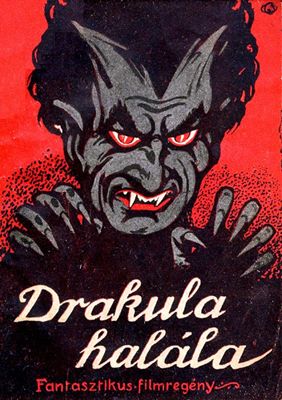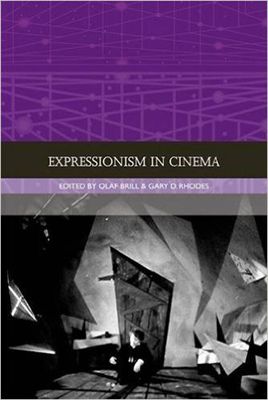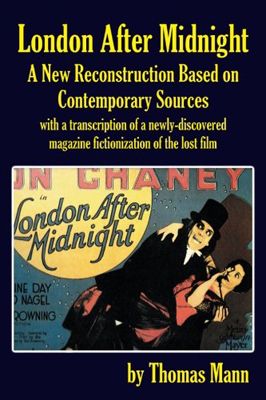



I know people, myself included, who, every Halloween watch classic horror films movies like Dracula (1931), Frankenstein (1931), and The Mummy (1932). I just watched the latter for about the tenth time—it still satisfies. I also watched the terrific UK thriller, The Clairvoyant (1935), with Claude Rains and Fay Wray. If you haven’t seen it, find a copy. I predict you’ll love it.
With Halloween just a few days away, there’s no better time to pick up some horror-themed film history. Might I recommend two recently released books from BearManor Media? One is London After Midnight: A New Reconstruction Based on Contemporary Sources, by Thomas Mann. It is an intriguing work of literary-filmic archeology.
Tod Browning’s silent horror film, London After Midnight (1927), starring Lon Chaney, has intrigued silent movie fans for decades. The movie is considered lost, and remains one of the most famous and sought after of all lost films. Every April 1st, it seems, somebody announces they have found it. Eureka!
The last known copy of London After Midnight was destroyed in a vault fire in 1967. Today, all that remains are surviving film stills, an illustrated novel, scripts, and other ephemera which give some feel for the actual film; however, gaps in the plot and other inconsistencies and missing elements leave viewers wondering how the actual film unfolded. (This, despite the fact that Turner Classic Movies aired a valiant reconstructed version, using the original script and film stills, in 2002.)
In London After Midnight: A New Reconstruction Based on Contemporary Sources, Mann offers a reconstruction based on his transcription of a rediscovered 11,000-word fictionalization of the film published in Boy’s Cinema, an English publication, a year after the film was released. Mann’s detailed comparison of surviving sources sheds new light on various “unsettling” aspects of the film, like the discovery of a second murder victim, a plot element not in the final film. Mann’s transcription of the story is included in the new book.
Another intriguing book from BearManor Media is Ed Wood and the Lost Lugosi Screenplays by Gary D. Rhodes. Here, noted film scholar and Bela Lugosi authority Gary D. Rhodes brings to light two of Ed Wood's unproduced scripts for the famed Dracula star, namely The Vampire's Tomb and The Ghoul Goes West. Rhodes is ably assisted by horror movie expert Tom Weaver, Lugosi biographer Robert Cremer, and Hollywood historian Lee R. Harris. Each dig deep into these unfilmed films, and in doing so, unearth all manner of previously unknown information and visual artifacts. Ed Wood and the Lost Lugosi Screenplays reproduces the two screenplays, and puts these horrific treasures on exhibit for the first time.
Another recent title well worth checking out is Expressionism in the Cinema, edited by Rhodes and Olaf Brill. Published by Scotland’s Edinburgh University Press (and available in the United States), this wide-ranging collection reworks the canon of Expressionistic cinema—which means it goes beyond the handful of German titles likely familiar to film buffs.
The book’s fifteen essays revisit key German films like The Cabinet of Dr. Caligari (1920), Nosferatu (1922), and The Hands of Orlac (1924), and also provide new consideration of more obscure titles like Nerven (1919), The Phantom Carriage (1921) and other films produced outside Germany—notably in France, Sweden, Hungary, Austria and elsewhere.
For me, the real eye opener is Rhodes’ contribution to the book, “Drakula halála (1921): The Cinema’s First Dracula.” Yes, you read that right. There was a “Dracula film” before F. W. Murnau’s classic Nosferatu (1922), and before Tod Browning’s familiar Dracula (1931).
Drakula halála, or Dracula's Death (sometimes translated as The Death of Drakula—following the Hungarian spelling), is a Hungarian horror film written and directed by Károly Lajthay. Like London After Midnight, it is presumed lost.
Drakula halála tells the story of a woman who experiences frightening visions after visiting an insane asylum, where one of the inmates claims to be Count Drakula. Echoing The Cabinet of Dr. Caligari, the woman has trouble determining what is real and what is not, and whether the inmate's visions are real, or merely nightmares. Though the plot of Drakula halála does not really follow the narrative found in Bram Stoker's famous novel, Dracula (1897), the film marks the first screen appearance of the vampire character we know as Count Dracula.
Released the following year, Nosferatu, eine Symphonie des Grauens (translated as Nosferatu: A Symphony of Horror) was in fact an unauthorized adaptation of Dracula, with names and other details changed because the studio could not obtain the rights to Stoker’s novel (for instance, "vampire" became "Nosferatu," and "Count Dracula" became "Count Orlok"). In his fascinating essay, Rhodes argues that Drakula halála beat Nosferatu to the punch. Or should I say, it got the first bite.
Thomas Gladysz is an arts and entertainment writer. He is also the founding director of the Louise Brooks Society, an online archive and international fan club on the web since 1995. Gladysz is currently working on The Films of Louise Brooks, which includes a chapter on the expressionist-tinged Pandora’s Box, which featured actor Carl Goetz, who plays “the meatman” in Drakula halála.
